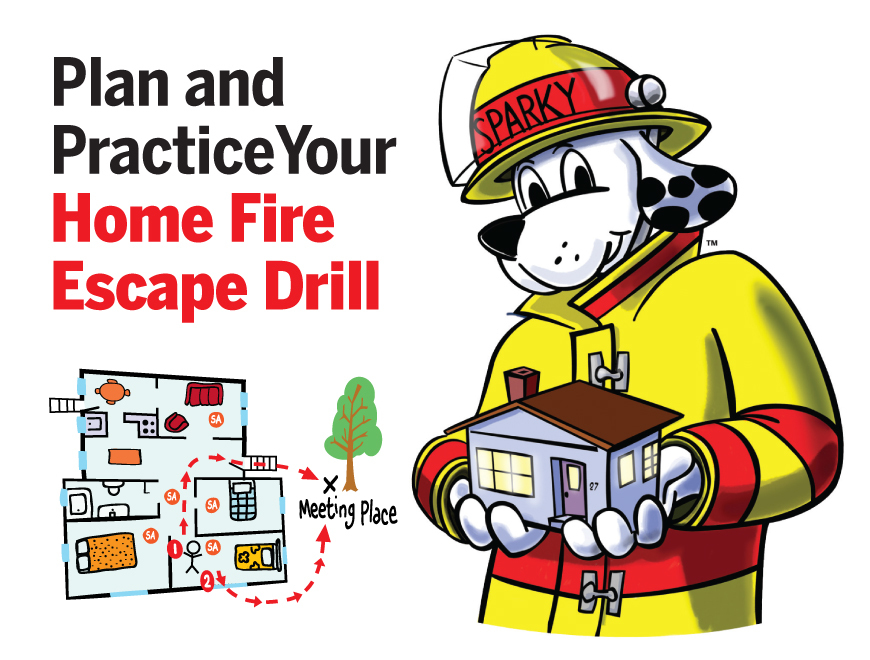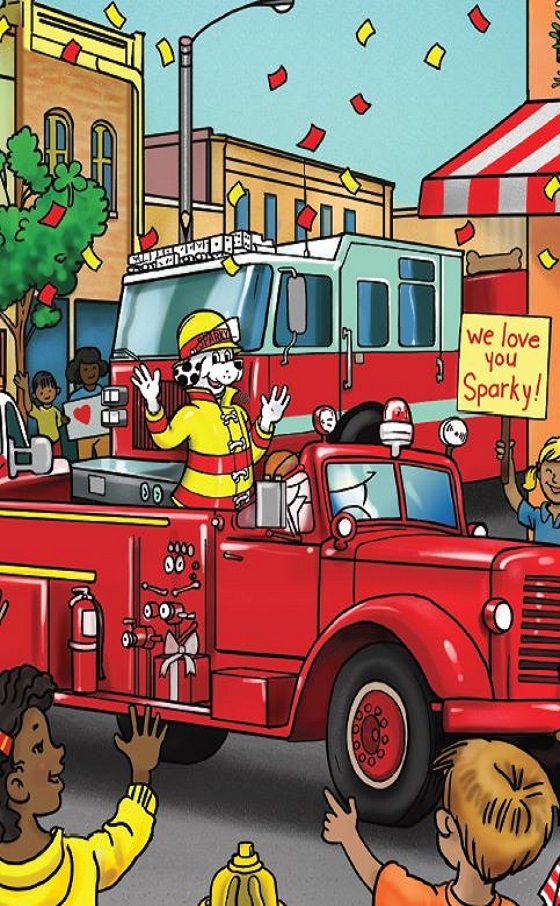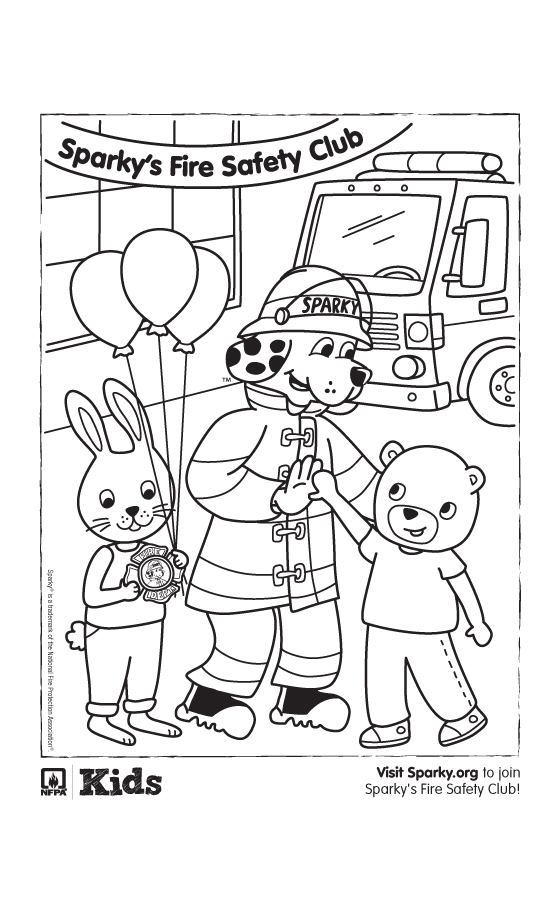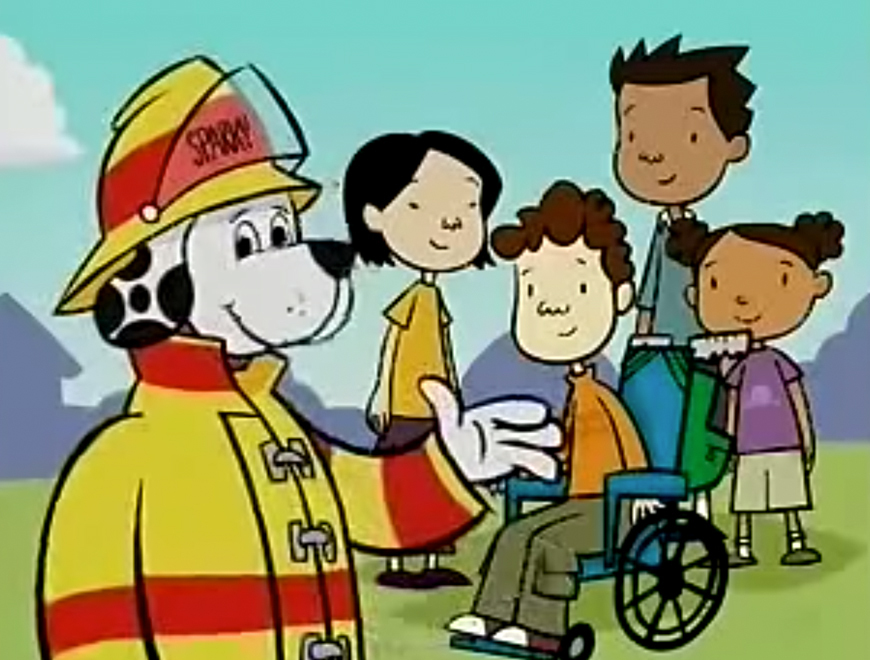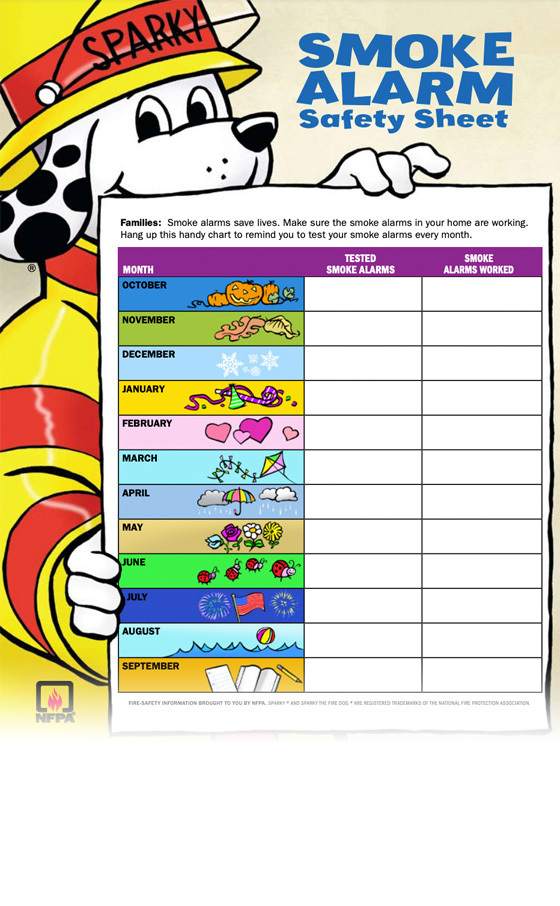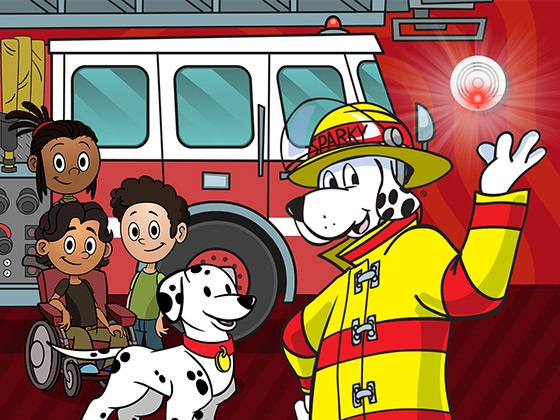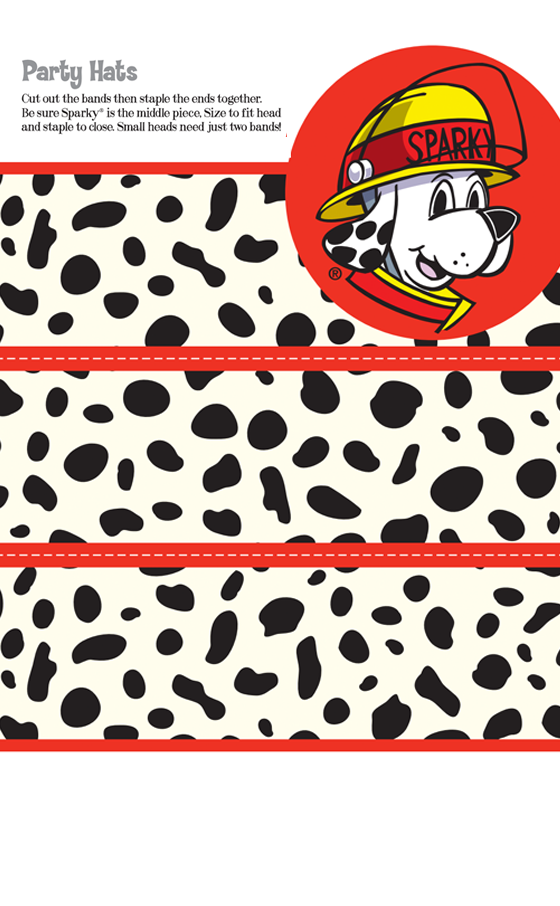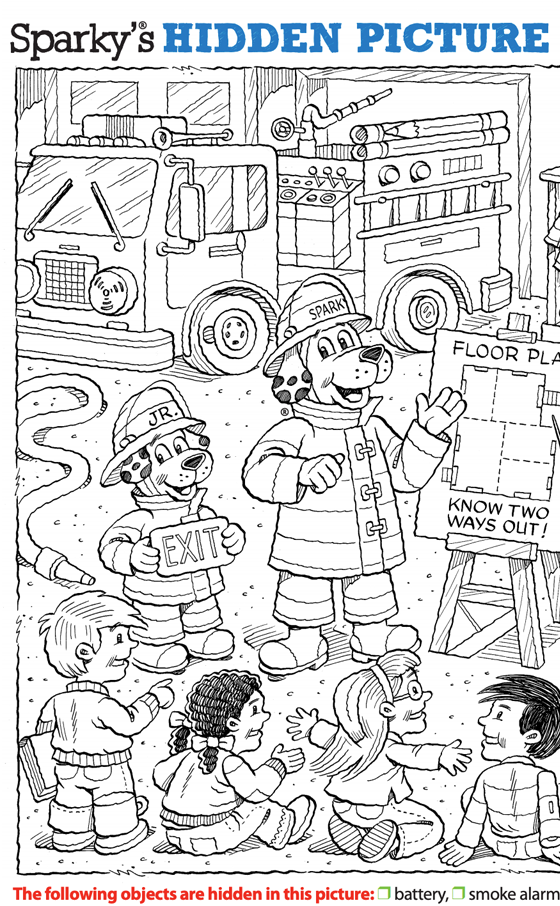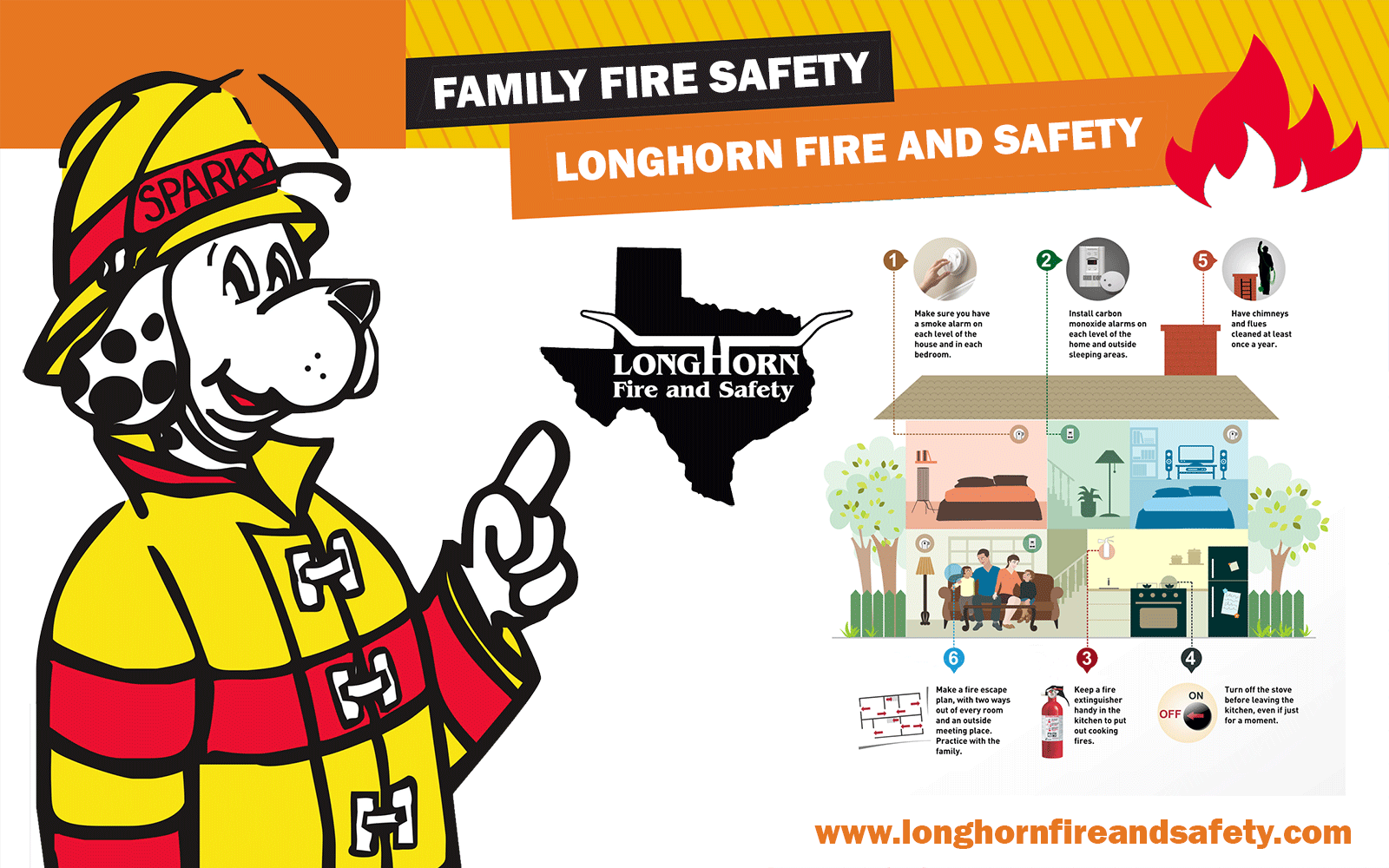
At Longhorn Fire and Safety, we take pride in helping families across the Texas Hill Country protect themselves, their loved ones, and their property with superior fire safety equipment and expert training.
We hope the kids activities and parent resources below will help your children and your whole family stay fire safe.
Activities for Kids
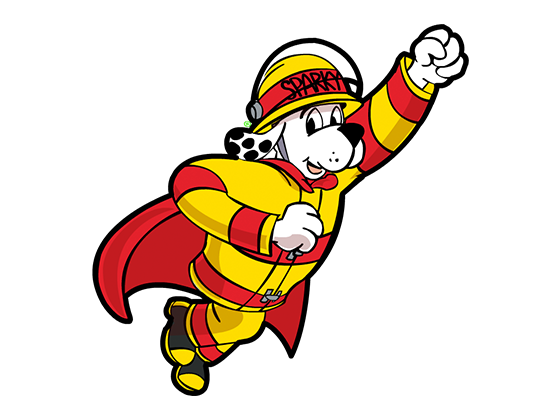

Fire Safety Checklist
Every family should have yearly fire safety
checks around their house. Here are a few tips on
what to look for as well as a Homework Assignment
for you and your kids.

Download Homework Assignment
Check Smoke & Carbon Monoxide Detectors Monthly
Make sure there is a working smoke alarms and carbon monoxide detectors on every level of your home, inside bedrooms and near sleeping areas. Test alarms every month and replace smoke alarms every 10 years and CO detectors every 5 years.
Create and Practice a Fire Escape Plan
Create a home fire escape plan with two ways out of every room. Practice a home fire drill at least twice a year with your family. Choose a place to meet outside that is a safe distance away from your home.
In an Emergency, Leave Home Immediately
Make sure your family leaves the home immediately if there is a fire. Choose the safest escape route. If there is a lot of smoke, get low and crawl out of the house as quickly as possible. Call 911 after you are a safe distance away from your home.
Home fires cause hundreds of deaths and injuries each year. Toddlers, pre-schoolers and kindergartners are most likely to start these fires, typically by playing with matches and lighters.
Children experience fire interest. They may ask questions such as how hot is fire or show an interest in fire through playing with fire trucks or cooking on a play stove. This is healthy, and it is time to begin educating about fire.
Firestarting happens when children begin to experiment with fire using matches and lighters. Many fires happen when young children are left alone, even for a short period of time, and have access to matches and lighters. Parents must have clear rules and consequences about fire misuse.
Grown-ups can help keep fire out of the hands of children. Store matches and lighters out of children’s reach and sight, up high, preferably in a locked cabinet or container. Never leave matches or lighters in a bedroom or any place where children may go without supervision.
Teach young children and school-age children to tell a grown-up if they see matches or lighters. Children need to understand that fire is difficult to control, it is fast and can hurt as soon as it touches you.
It is important for grown-ups to discourage unsupervised fire starts. Never use lighters or matches as a source of amusement for children; they may imitate you.
For Parents
1. Locate all of your home’s fire extinguishers.
Make sure that you have a fire extinguisher located on each floor of your home and in the garage as well. Mount fire extinguishers no higher than 5 ft from floor for optimal fire protection coverage in your home or business.
Action Steps:
- Make sure fire extinguishers are visible and
in a designated area.
- All family members have been made aware of
where the fire extinguishers are located.
2. Review how to properly use fire extinguishers in the event of a fire.
Even though we may have sufficient fire extinguishers in the home to cover the entire home living and storage spaces, we still need to make sure everyone in your house is well aware how to operate an extinguisher. A popular method for using a fire extinguisher is the Pull, Aim, Squeeze, and Sweep or P.A.S.S method. Here is a link to the OSHA website that talks more in depth about the P.A.S.S method.
Action Steps:
- Train your family members how to hold and
actuate the fire extinguisher.
- Educate your family members about the
differenttypes
of firesand the importance of using theoper
extinguisherfor the type of fire
encountered.
3. Ensure the tamper seal on your fire extinguishers are not broken.
On your home fire extinguishers you should make it a point to make October fire prevention month in your home, and take a few minutes (it will likely take only a few) and check the seals on all the fire extinguishers. Most likely the seal is only broken if it has been used and the contents have been discharged, but it may have happened accidentally. Either way, it’s well worth the few minutes it takes to confirm that all are intact and ready for discharge if needed.
4. Check the pressure of your fire extinguishers monthly.
Typically, fire extinguishers have a round pressure gauge located towards the top of the extinguisher. Make sure the needle is in the operable range. If your extinguishers are equipped with a test indicator, press the indicator and make sure the pressure reading is in the proper range.
Action Step:
- Perform monthly inspections to ensure fire extinguishers have the proper amount of pressure. (A good rule of thumb is to check each first day of the month.) Need some help, call us at (512) 258-7233
5. Make sure the extinguishers are free of clogged nozzles, corrosion, and/or physical damage.
When you encounter a fire, you want to know you have a fire extinguisher that functions properly. It is recommended that you inspect your fire extinguishers annually for any defects.
Action Steps:
- Perform annual inspections on your fire extinguishers to ensure they are free of physical damage, corrosion, and clogged nozzles.
6. Confirm that smoke alarms and carbon monoxide detectors are working.
Part of every fire prevention plan should include installation and maintenance of smoke alarms and carbon dioxide detectors. They should be checked monthly to ensure proper operation.
Action Steps:
- Install smoke detectors and carbon monoxide
detectors are on every level of your home and in
living areas, including each bedroom.
- Test your detectors monthly to ensure they are
in proper working order
- Change the batteries twice per year (ie. At
the time change to and from daylight savings
time).
- Replace detectors that are 10 years old
and older (Or, when the unit chirps, which is
low-battery signal).
- Vacuum and clean detectors regularly.
7. Perform regular chimney inspections and maintenance.
While many factors are involved in how often a chimney should be inspected, it is a good idea to have a professional inspection done annually. An inspection will help determine whether or not your chimney needs cleaned. Regular cleaning helps prevent buildup of creosote, which is a combustible by-product of charred wood. While we don’t endorse any particular company, we have had good success and satisfaction withCoalway. They have locations in our area at Apple Creek and Charm, Ohio.
Action Steps:
- Have annual inspections done
- Have a chimney professional clean your chimney
regularly
- Make sure tree branches are at least 15 feet
away from your chimney
8. Create and regularly review your family’s fire escape plan.
The cornerstone of every fire prevention plan is a fire escape plan. It is important to have a plan in place and make sure that all family members understand each part of the plan. If you have not created your fire escape plan, here is alinkfrom the Division of State Fire Marshal’s office to help you develop your fire escape plan.
Action Steps:
- Make every family member aware of how the fire
escape plan is performed and reinforced with
periodic fire drills.
- Make sure that furniture placement will not
impede your designated exit strategy.
9. Stock and maintain an emergency supply kit.
An important part of every fire escape plan is an emergency supply kit. Depending on the climate or location of your home, fire response may take an extended amount of time. Preparing for these types of situations helps prevent a bad situation get worse. An emergency supply kit can be kept in an easily accessible location so that is can be picked up quickly in the event of a fire. An outdoor building such as a tool shed or detached garage is ideal place to store an emergency supply kit.
Action Steps:
- Put together an emergency supply kit that
contains blankets, clothing, nonperishable food,
safety supplies, and water
- Store the emergency supply kit in an easily
accessible location in the event of a fire.
10. Make a regular interior and exterior walk-through.
A key practice of fire prevention is performing regular visual checks of the interior and exterior locations of your property. While there is no rule of thumb as to when to perform these checks, try to stay on the lookout at all times for potential fire hazards.
Action Steps:
- Extension cords are of the right size, in the
open, not under rugs or through partitions or
openings, and they are for temporary use only
- Electrical outlets are not over loaded and
functioning properly
- Attic, basement, closets and yard are all free
of rags, papers and combustible materials
- Lint filter on clothes dryer is cleaned
after each use
- Gasoline and kerosene are stored in properly
designated and marked containers
- Matches and lighters are kept away from
sources of heat
Kitchen Safety
Store all items away from your
stovetop!
Keep anything that can catch fire, such as dish towels or
wooden spoons, away from your stovetop. Use back burners to cook, if
possible. Have a kitchen fire extinguisher in the kitchen in case of emergency, and
make sure you know how it works.
Never throw water on a kitchen
fire!
There are close to 155,000
kitchen fires a year, many caused by heating fat
or oil. Never, ever throw water on a kitchen
fire—it won't put it out and could cause a steam
burn. Try to cover the flames with a lid. Next
option: Toss a damp cloth over them or, better
yet, use a kitchen-designated fire extinguisher
that packs special dry chemicals geared toward
putting out oil fires. Longhorn Fire and
Safety has kitchen fire extinguishers for
residential and commercial kitchens in Austin,
Texas.
Candle Safety
With kids around the house, having lit candles is extremely dangerous
and is the number #2 cause of house fires in
America. If you must have candles lit, keep them high and out of reach of your little ones and always blow them out when you leave the room or
most definitely --- before you go to sleep.
Lighters & Matches
Having lighters and matches lying around your house for children to find is asking for trouble. Keep them stored in the highest cabinet out of reach of any child. Always buy childproof lighters!
Dryer Lint - Clean it!
With many high-efficiency dryers on the market, it is imperative to remove the lint build-up from inside your dryer after every load. It is also a good idea to clean your dryer vent regularly every six months. Old lint clogging your vents can overheat and catch fire. It is advisable every six months to blow your vent hose behind your dryer with a blower to help blow away any clogs in your vent stack.


